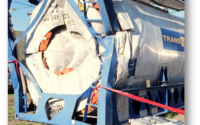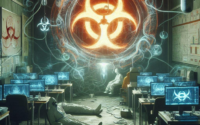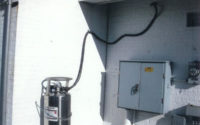PPE, A False Sense of Security
Kevin Ryan
I recently had a discussion with (2) experienced veterans of the Baltimore City FD about our Personal Protective Equipment (PPE). The members had 40 plus years on the job with assignments in the busiest companies Baltimore has to offer. The discussion was centered around how well protected we are in our Turnout Gear and SCBA. The Nomex or PBI hood was the biggest change they had seen in their time. We are so well encapsulated that we lose a sense of the environment we are in. Hoods do so well at protecting our ears and neck that we never really get a sense of just how hot it is when making a push on the fire. Members now push deeper into the dwelling before we ever realize that we are in an untenable atmosphere. Our situational awareness is quickly compromised once we get into full turnouts and SCBA. Dave and Charlie really gave me a lesson in how we should approach our PPE selection for hazmat response. We must realize that our PPE is a false sense of security. The very first limitation we must consider is our members. Quality training (there is that phrase again) must expose these limits to our members. The physical and mental fitness of our hazmatters is priority. How do we assess these two traits? Physical traits are much easier to size up than the mental aspect. Required medical exams as directed by OSHA are a good place to start. The BCFD takes exams on a bi yearly basis given the logistics of sending 140 members through our Public Safety Infirmary for evaluation. The bi yearly exams still meet OSHA criteria as the AHJ can determine the exam frequency. The process gives a good measuring stick for the physical fitness of our hazmatters. The assessment of a member on the mental level is much more subjective. How will a technician student react the first time they are placed inside an encapsulating suit in training? A good instructor will be able to put the student at ease. The breathing process is key in working inside a plastic bag. Nervous students will have to deal with a heightened sense of anxiety once they feel that zipper close.

The instructor can assist by talking to them through the breathing process. Once a student controls their breathing, the confidence quickly comes to them. The mind is now free to focus on developing the skills to operate with reduced vision, dexterity, and hearing. Advanced technicians can build confidence in many ways. Training that presents the biggest challenge gives the largest boost in confidence. I can remember a confidence drill I took part in at Delaware Hazmat Weekend.
The training was conducted by Ret. Dupont Experimental Station Chief Daryl Meade as part of a suit emergencies class. Students removed their regulator from their SCBA inside a Level A suit allowing carbon dioxide to fill the suit. The student had a 4 Gas meter inside the suit to monitor oxygen levels. I clearly remember the struggle to breathe easy once I reached 12% O2. You really had to control your breathing to maintain your calm. Once breathing is controlled, you can quickly replace your regulator to breathe normal air again.

Proper breathing can allow a student to remain calm. The student must learn to accept the challenge rather than the struggle to breathe. The drill is great for building suit confidence and developing the hazmatter’s mental performance. I would recommend that you take all necessary precautions if you attempt this type of training. O2 levels below 19.5% are IDLH and you must plan the training accordingly.

Live agent training is an excellent way to learn suit limitations. Dave Binder of Tanner Industries provides hands-on training with live ammonia. The evolution consists of students in Level A performing a tarp and cover scenario on a live ammonia release. The students get to feel the cool rush of ammonia on their feet as the tarp is pulled down to the ground. The quick blast of cold gas teaches students that their PPE is not immune to temperature change. A real-world limitation is felt as they secure the tarp to the ground. The evolution is quality training that teaches PPE limits. PPE limitations must be a part of good tactical decision making. PPE selection based on the tasks being performed is a skill as well as an art form. The environment, task performed, time required, and other considerations need to be made. The BCFD took a response at a dialysis clinic for spilled chemicals. The chemical was a strong oxidizer that was in a storage room. The spill from several 5-gallon containers had soaked several pallets and left puddles on the floor. The objectives were to overpack damaged containers, remove contaminated pallets and clean up liquids on the floor. PPE choice could have been Chemical or Fire PPE. What would your call be? The BCFD chose Fire PPE with SCBA. How did we justify our decision? The determining factor came because of the soaked pallets now becoming a greater fire hazard after getting soaked with Oxidizer. Members could place pads and manipulate with handles or poles preventing foot or hand exposure. The skill of PPE selection is understanding what Fire or Chemical PPE is intended for. The art of applying those skills comes in recognizing the increased fire hazard of oxidizer-soaked pallets. PPE is the means that allows us to perform work in hazardous areas. We must remember that PPE has its limitations. The limitations must be factored into our decision-making process when sizing up an incident. Quality training is the best way to attack the false sense of security that PPE lulls us into.



